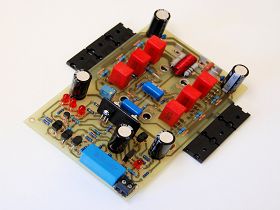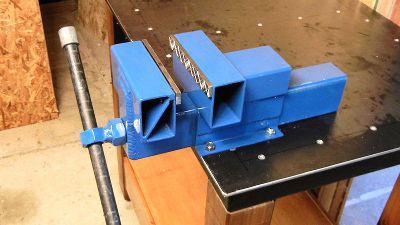Building A Drill Press Cabinet Workshop Projects
This drill press cabinet was a long time coming. I started and finished this project months ago, back in January of this year, in fact. At the time, I put off doing the article because I wanted to get the plans for this project ready as well, but got sidetracked with other projects and my move to another house.
It’s now almost a year later, and I’m currently making storage and organization projects for my new shop, so I thought it would be a good time to finish this article. The plans for it are not ready yet, but are coming soon.
To get started, I cut up an old folding table made from 3/4″; particle board into parts for the two sides and lower shelves:
.jpg)
It’s always nice to get usable material for nothing, and this is a good example.
The left side panel needs to be cut for the door that allows the front to swing open, and I did a stop cut on the table saw:
.jpg)
Then completed the cut from the front. There are other ways to make these cuts, but the table saw does it well – a straight, clean cut and the right kerf for the hinge I will use:
.jpg)
The door panel with the piano hinge in the gap – a perfect fit. I generally don’t like using piano hinges, but it is the best choice for this.
The slight over cut from the table saw on the inside of the panel will be hidden when the rest of the unit is assembled:
.jpg)
The interior has some small cubbies for various accessories – hole saws, sanding drums, etc, and these are on the left side of the unit. I’m using 1/2″; G1S plywood to make these. To support these small shelves, I’m using biscuits. I’ve removed the fence from the tool and clamped a guide to the side panel. I put the joiner against that to cut the biscuit slot in the side:
.jpg)
To cut the slots in the shelves, I shimmed them up off my workbench and used the tool without the fence. I had to do it this way because the fence on my biscuit joiner would not go down far enough to be used in the usual way. For those of you that don’t have or don’t like biscuit joinery, fear not – the plans for this project detail dados for these (and all other) shelves:
.jpg)
Because the shelves are so small, a single #20 biscuit and glue will be enough support. I took the time to round over the front edge of each shelf before assembly:
.jpg)
Using some homemade clamps to hold it together while the glue dries:
.jpg)
While waiting for the glue to dry on the cubbies, the other side panel was edge banded with 3/4″; thick pine:
.jpg)
Using some of my homemade edge clamps to hold it while the glue sets. Regular clamps could also be used, or just brads.
I’m using thick, solid wood for the edge treatment, but thin veneer tape could also be used:
.jpg)
With the clamps removed from the cubbies, I can do a dry fit to check for alignment:
.jpg)
The two lowest shelves support the drawers at the bottom of the unit. The one above is an actual shelf, reserved for the vises.
I’ve laid out the locations for each of the shelves on both side panels. Again, biscuits will be used to joint the shelves to the sides:
.jpg)
Before joining the top shelf to the side, a back is added:
.jpg)
The shelf is then glued in place on the left side panel. Because the plywood has a finish, I’m using polyurethane construction adhesive. Ordinary wood glue will not stick:
.jpg)
The other two shelves and right side panel are glued and clamped:
.jpg)
The door needs a rabbet to receive the backer panel for the slot wall section:
.jpg)
I used 1/2″; melamine as the backer, mainly because that’s what I had on hand. It is a good choice, since it stays flat.
I filled the rabbet below with a piece of pine:
.jpg)
Time to screw the hinge onto the back of the slot wall section:
.jpg)
I drilled pilot holes and put a screw in every hole in the hinge. The slot wall will have a fair amount of weight on it, so maximum support is important.
Next, the cleats that make the slots are cut from spruce and installed. These are rabbeted on one edge:
.jpg)
To calculate the spacing, I put all of the cleats together and measured what was left. I then divided that by the number of cleats minus one, the number of spaces between the cleats. The cleats are glued on with polyurethane construction adhesive with pin nails to hold them while the glue dried. If you need to glue something to melamine, this is the way to go, as it makes a permanent bond.
Next, the top is glued on using some creative clamping:
.jpg)
Time to attach the slot wall section:
.jpg)
A very good fit:
.jpg)
Satisfied with how it looks, I removed it and put a bead of polyurethane construction adhesive where the hinge screws on. This is insurance and will help keep the hinge from loosening. Short screws don’t really hold well in particle board.
With the main part of the cabinet finished, I moved on to making the drawers. Again, I did something that is completely out of character for me: I made the drawers totally from solid wood. Normally, I’d consider this to be a fairly poor choice for building drawers, with plywood being a much more suitable material. Once again, I must have been trying to impress someone.
Even so, I stayed true to my nature when I picked out the poorer pieces and off cuts of pine left over from doing my family room floor.
The first parts I made are the bottoms for the drawers, since these had to be glued up to make the right sized panels. I milled the pine down to 1/2″; thick, glued the pieces together and set them aside to dry.
I selected the worst pieces for this, saving the better stock for the sides and front:
.jpg)
The sides are cut next, 3/4″; thick:
.jpg)
The next cut is a 3/4″; dado to receive the back of the drawer, then a 1/4″; dado to receive the bottom panel:
.jpg)
The back, bottom corner of each side is then trimmed off. This is to allow the drawer to be removed from (or put into) the cabinet:
.jpg)
Next, the front and back for both drawers are cut, and to join the front of the drawers to the sides, I’m using box joints:
.jpg)
My box joint jig makes quick work of it.
The bottom panel needs a rabbet on three sides to fit into the dados:
.jpg)
Note the grain direction of the bottom – across the width of the drawer. This is to eliminate seasonal expansion / contraction side to side, to keep the drawer from sticking during times of high humidity.
With the drawers finished, it was time to give the cabinet a sanding, and then hang it on the wall:
.jpg)
The three lower shelves still needed to be banded, and again, some creative clamping. The pipe clamps pull the sides in tight, and to press the banding on, wedges are inserted between the pipe and the banding:
.jpg)
Some simple wooden pulls are made for the drawers:
.jpg)
Loaded up:
.jpg)
Along with the cubby storage, there is a dedicated space inside for my drill press table:
.jpg)
That was one of the design criteria: that it would be a convenient place to store the table when I’m not using it.
I divided the drawers into sections for different size range and types of drill bits:
.jpg)
If there was one build that absolutely convinced me that time is well spent doing projects to organize the shop, this would be it. I would estimate it has saved me hours, literally, over the past year, because it is so easy to find what is needed and easy to put it back.
If you would like to build one of your own, plans are available.















